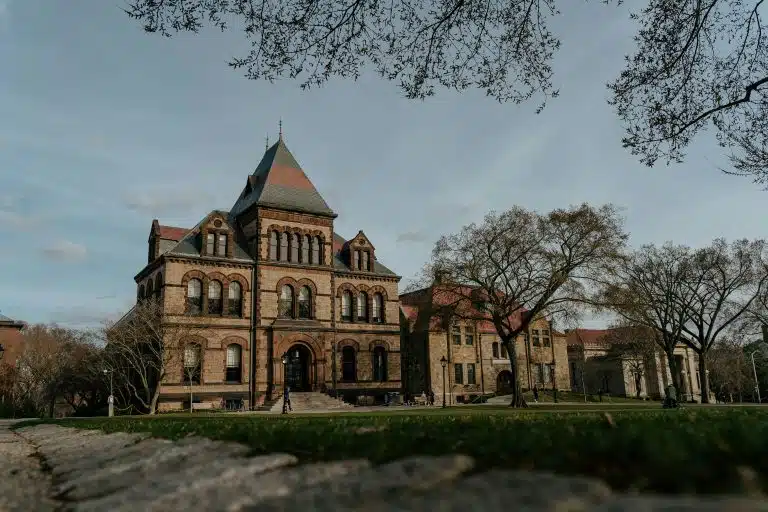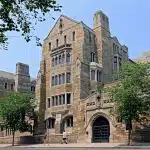Brown University is a dream school for many high school students. Located in Providence, Rhode Island, it’s known for its open curriculum and rigorous academic programs across various fields. That’s why getting in isn’t easy. Brown’s admissions process is ultra-competitive, and they’re looking for intellectually curious applicants with a genuine desire to make an impact in their communities. In short, you’ll need more than good grades to stand out.
In this blog, we’ll break down how hard it is to get accepted, what Brown really looks for in applicants, and what you can do to show you’re a great fit.
- What Does Brown University Look For?
- How Hard Is It to Get into Brown University?
- How to Stand Out to Brown University
- Frequently Asked Questions
- Takeaways
What Does Brown University Look For?
A Brown education helps students become “independent thinkers, innovative collaborators, and active global citizens.” Because of that, the university looks for self-motivated students who have the following qualities:
1. Intellectual curiosity
Brown is known for its innovative, interdisciplinary approach to learning. To get in, you must show that you’re intellectually curious, open to new ideas, and excited to explore different perspectives.
One of the best ways to do this is to highlight any research projects, independent studies, or personal academic interests you’ve pursued outside of school.
Maybe you explored computational biology on your own or joined summer programs like the Telluride Association’s Summer Seminar (TASS). Whatever it is, Brown wants to see that you take initiative and go beyond what’s expected in the classroom.
2. Academic excellence
Intellectual curiosity goes hand in hand with academic excellence at Brown. The university wants to see that you’ve challenged yourself with rigorous courses, such as Advanced Placement (AP) and International Baccalaureate (IB) classes (and excelled in them, of course).
In addition, Brown pays close attention to how your academic strengths align with your chosen major, so make sure to highlight any standout achievements or meaningful educational experiences in that area.
For example, if you plan to major in History, you might mention competing in the National History Bowl, conducting an independent research project on postcolonial movements, or writing an award-winning paper for your AP U.S. History class.
3. Community engagement
Brown values students who want to make a positive impact in their communities. They look for applicants who actively engage with others to create change through service, activism, or leadership.
One way to highlight your community involvement is to consider any extracurricular activities or volunteering experiences that reflect your passions, especially those connected to your major or academic interests.
Maybe you volunteered to teach coding to underprivileged students or developed an app to help local nonprofits manage their resources more efficiently. If you’re interested in computer science, these experiences show how you’ve used your skills to give back to your community.
4. Resilience and adaptability
Brown is known for its rigorous academics, so they’re obviously looking for applicants who can manage all that pressure.
To show your resilience and adaptability, think about any challenges you’ve faced and how you overcame them. It doesn’t matter whether it’s a personal or academic challenge; what’s important is that you show Brown you can learn from tough experiences and stay on track, even when things don’t go as planned.
For example, you struggled with a Calculus class but kept working hard, sought help from a tutor, and eventually improved your grades. Or perhaps you faced a personal setback, like the death of a family member, but still managed to stay focused on your goals, like continuing your role as volleyball captain despite the challenges.
How Brown evaluates applications
Now that you know what Brown looks for in applicants, how do you break that down as you put your application together?
Let’s go over how Brown actually evaluates applications based on their 2024-2025 Common Data Set:
| Factors | Very Important | Important | Considered | Not Considered |
| Rigor of secondary school record | X | |||
| Class rank | X | |||
| Academic GPA | X | |||
| Standardized test scores | X | |||
| Application Essay | X | |||
| Recommendation (s) | X | |||
| Interview | X | |||
| Extracurricular activities | X | |||
| Talent/ability | X | |||
| Character/personal qualities | X | |||
| First generation | X | |||
| Alumni/ae relation | X | |||
| Geographical residence | X | |||
| State residency | X | |||
| Religious affiliation/commitment | X | |||
| Volunteer work | X | |||
| Work experience | X | |||
| Level of applicant’s interest | X |
Brown’s Common Data Set shows that academics are a top priority, with every category marked as “Very Important,” including standardized test scores, which are now required again.
When it comes to non-academic factors, Brown strongly emphasizes talent/ability and character/personal qualities, both of which are marked as “Very Important.”
Again, highlight your intellectual curiosity, adaptability, and community engagement in your application. Show Brown what you’re passionate about and what skills you’ll bring to campus, and you’ll have a strong chance of getting accepted.
How Hard Is It to Get into Brown University?
It’s very, very hard. Brown is currently tied at #13 in the U.S. News & World Report’s Best National Universities rankings, alongside Columbia University.
Brown is also an Ivy League school, and getting into any of the Ivies is extremely tough. After all, their exclusivity is part of what makes them so prestigious. Like other Ivies, Brown receives tons of applications each year and only accepts a select few.
Brown University acceptance rates
Brown’s acceptance rate for the Class of 2029 was just 5.65%. Out of nearly 42,756 students who applied, only a little over 2,400 were accepted. That tells you just how selective Brown really is—they’re looking for the best of the best.
Now, starting with the 2024-2025 application cycle, Brown’s bringing back the requirement for first-year applicants to submit SAT or ACT scores. But before that, the process was test-optional, which is probably why there were record-high application numbers and even lower acceptance rates.
Let’s take a look at Brown’s acceptance rate over the last few years:
| Brown University Class | Number of Applications | Acceptance Rate |
| 2029 | 42,756 | 5.65% |
| 2028 | 48,898 | 5.16% |
| 2027 | 51,302 | 5.08% |
| 2026 | 50,649 | 5.03% |
| 2025 | 46,568 | 5.45% |
As you can see, Brown’s acceptance rate hovers just around 5%. While this may be one of the higher rates in recent years, it’s still very competitive. To have a real shot at getting in, you’ll need to craft a well-rounded application, including high grades, extracurricular activities, strong essays, recommendation letters, and a compelling personal story.
One of the best ways to increase your chances? Understand exactly what Brown looks for in applicants and start building your profile around those qualities early on in high school.
How to Stand Out to Brown University
Brown has a holistic review process, meaning they don’t base decisions solely on your GPA or class rank. Considering the eight factors (course rigor, class rank, academic GPA, standardized test scores, application essay, recommendations, talent/ability, character/personal qualities) they listed as “Very Important,” here are suggestions for how to make your application stand out:
1. Rank in the top tenth of your high school class and take challenging courses.
Brown doesn’t have a minimum GPA, but around 92% of accepted students rank in the top 10% of their graduating class. By this, you pretty much already know the kind of academic excellence Brown is looking for. If you’re in the earlier years of high school, don’t worry; there are plenty of ways to get your GPA up.
Brown also understands that not all high schools offer AP classes. If your school doesn’t offer APs, that’s okay. Brown just wants to see how you’ve taken advantage of the opportunities available to you. Many motivated students supplement their high school curriculum with college courses or independent study when needed.
For example, Brown’s Rural and Small Town Student Fly-In Program shows the university’s commitment to attracting students from all types of high schools. This program offers students from rural and small-town schools the chance to attend a college prep boot camp at Brown, free of charge.
If your school does offer AP classes, keep in mind that Ivy League students typically complete between eight and twelve AP courses (or even more!) during high school.
2. Aim for a 75th percentile score: 1560 SAT or 35 ACT.
Again, while Brown doesn’t have a strict cutoff, aiming for high standardized test scores will make you a more competitive applicant. According to Brown’s Common Data Set, a 1560 on the SAT or 35 on the ACT puts you in the 75th percentile, which is a good target.
| 25th Percentile | 50th Percentile | 75th Percentile | |
| SAT Composite | 1510 | 1540 | 1560 |
| ACT Composite | 34 | 35 | 35 |
Brown also superscores the SAT and ACT, meaning they’ll consider your highest scores from multiple test dates. We recommend taking your chosen test two to three times to maximize this opportunity, especially if you believe you can improve even by just two to three points.
3. Write compelling essays.
When applying to Brown, you’ll need to complete the personal essay as part of the Common Application, along with Brown-specific supplemental essays. These essays are your chance to showcase your personality, passions, and unique experiences, so take advantage of them!
Admissions wants to learn more about who you are beyond the numbers, so use your essays to share your story and demonstrate your fit with Brown’s culture of intellectual curiosity and community involvement.
It’s important to give yourself enough time to brainstorm, draft, and revise your essays. And if you need any help, you can always work with an editor to help refine your essay and make sure it reflects your best skills and abilities.
4. Get strong recommendations.
Brown places significant weight on letters of recommendation, so make sure to submit at least two letters from teachers who’ve taught you in major academic subjects like science, social studies, math, a foreign language, or English.
Remember, Brown sees talent/ability and character/personal qualities as “very important,” so choose teachers who can speak to these traits and your academic strengths.
Teachers are busy people, and writing letters of recommendation is a big task. Make it easier for them by asking ahead of time and providing any relevant information they might need, such as your academic goals, achievements, and specific experiences in their class.
5. Apply early.
While Brown says that demonstrated interest isn’t a factor in the application process, the fact is that fewer students apply early. Statistically, applying early can boost your chances of acceptance.
For example, Brown’s Early Decision (ED) acceptance rate for the Class of 2029 was 17.9% (the highest in over five years!) compared to the regular decision acceptance rate of just 4%. 906 early-decision applicants were accepted out of 5,048, so that’s a pretty high chance.
But remember, you should only apply early to Brown if it’s really your top choice since you’ll need to commit to attending if you’re accepted.
Frequently Asked Questions
1. What are the qualities of a Brown student?
Brown students are intellectually curious, resilient, and adaptable. They embrace academic challenges by taking rigorous courses or starting independent projects. They’re also committed to making a positive impact on their communities, whether that’s through a leadership role or meaningful involvement.
2. What is the Brown Applicant Portal?
The Brown Applicant Portal is an online platform where you can monitor your application status, confirm receipt of application materials, and receive admission decisions. After submitting your Common App requirements, you’ll gain access to this portal to keep track of your application.
3. Does Brown require interviews?
No, Brown no longer requires interviews. Instead, they encourage you to submit a two-minute personal video introduction as part of the college application. This video allows you to share more about yourself beyond your grades, test scores, and other parts of the application.
Takeaways
- Brown’s admissions process is highly competitive. To have a shot, you’ll need a well-rounded application that aligns with what Brown values in applicants.
- Brown looks for students who are intellectually curious, excel academically, are involved in their communities, and show resilience through challenges.
- Brown evaluates applications based on eight “very important” factors: course rigor, class rank, GPA, standardized test scores, application essays, recommendations, talent/ability, and character/personal qualities.
- To stand out, aim for a high GPA, take challenging courses, get strong letters of recommendation, and write compelling essays that showcase your passions and character.
- If you need help with your Brown application, consider working with a private admissions consultant for expert advice and personalized guidance.

Eric Eng
About the author
Eric Eng, the Founder and CEO of AdmissionSight, graduated with a BA from Princeton University and has one of the highest track records in the industry of placing students into Ivy League schools and top 10 universities. He has been featured on the US News & World Report for his insights on college admissions.













